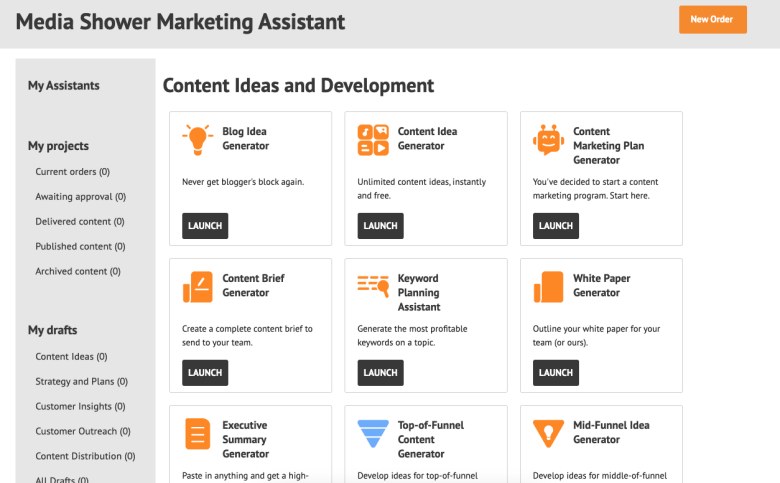
In marketing, there is no bigger topic of conversation than generative AI. This new technology represents a paradigm shift in the creative industries, causing excitement and concern in equal measure.
At Media Shower, we’ve spent the past two years exploring how to best help marketers utilize this new technology. At the same time, we still have humans, our award-winning creative team, doing the work. (There’s a human writing this now.)
We’ve developed a philosophy around AI: that it serves as an accelerating technology for marketers, to help them become much more productive — but human creativity is still needed for greatness.
In this guide, we discuss our AI principles, which we are sharing freely in hopes that it will help you navigate this new technology, too.
History is Repeating Itself
For us, AI is just another technology revolution. History is filled with examples of new technologies that shook the foundations of society, from the printing press to the Internet. These technologies generally make people much more productive, and reshape jobs (and entire industries) in the process.
Consider the Industrial Revolution: the use of machinery to perform tasks previously accomplished by humans was heralded as a new dawn for production. Companies could build things faster, on a massive scale, with far fewer errors.
This was frightening for many workers, and even today is a perceived threat in many industries. A 2019 Pew Research study showed that 48% of participants felt that automation would have largely negative consequences for workers in the U.S. Several industries, especially those like automotive or other manufacturing, saw automation as a threat to their livelihood.
Today, we can’t imagine a world without it. As old jobs are made far more productive, new jobs emerge, and the economy grows. Instead of taking one month to build an automobile, the automated assembly line reduced the time to one day.
The same thing is happening today with generative AI:
- According to a survey from Authority Hacker, over 81% of marketers felt their jobs were at risk due to AI. However, 49% reported using AI multiple times weekly for their work in this same survey.
- Another survey from Influencer Marketing Hub indicated that 60% of respondents have been using AI throughout their marketing operations.
- However, a survey from Ipsos reports that 46% of people surveyed think we’re moving too fast into AI development.
AI is an Accelerating Technology

Many marketers are afraid that AI will replace their jobs, as copywriting, digital design, and video production are seemingly being replaced by artificial intelligence. There’s a fear that it will replace human creativity rather than enhance it.
In our view, great marketers will always be needed.
In fact, AI accelerates the creative process by quickly producing “rough drafts” to which talented marketers can add human creativity. It’s not “AI versus humans,” but “AI plus humans.”
Seeing AI as a “first draft” technology, which humans can then polish and perfect, gives marketers a tremendous boost in productivity:
- Content: AI provides plenty of raw material for writers who don’t want to start from scratch. However, our rule of thumb is that all AI-generated content is about 85% “ready.” The other 15% needs to come from human creatives to make it great.
- Research: AI tools allow marketers to do research more quickly than ever before: a streamlined way to gather data, identify search trends, develop customer insights, and much more.
- Planning and Strategy: AI helps marketers better handle the “bigger picture” by providing campaign outlines and ideas that marketers can customize to their brand, company, or campaign.
- Inspiration: AI is like having a brainstorming partner sitting by your side, all day long. It can instantly generate headlines, titles, subject lines, etc., and “kickstart” a busy marketer’s imagination.
How We Are Using AI (Our AI Development Timeline)
At Media Shower, we’re creating the world’s leading marketing platform by combining the best parts of AI technology and human creativity. Our AI assistants enable marketers to draft great marketing materials, which they can then send to our award-winning creative team to polish and perfect.
Our target audience is busy marketers who need to do a lot of creative work, every day. Our AI assistants greatly accelerate the brainstorming, research, and planning phase – allowing marketers to put on the final coat of creativity and polish.
Prompting and Resources
 Our Email Subject Line Prompt Page
Our Email Subject Line Prompt Page
Our first experiments with AI were our Resources pages. At first, these pages listed best practices around whitepapers, headlines, etc., with ChatGPT prompts that we had tested on our own. Readers could simply copy and paste the prompts into their own AI tool.
The results were good, as we saw thousands of people using the prompts for their own campaigns. But using copy-and-paste text wasn’t the best way to help marketers. We could do better.
The Assistants
 Our LinkedIn Headline Generator
Our LinkedIn Headline Generator
The next step was making this experience interactive. We developed AI chatbots (or “Assistants”) that interfaced directly with the OpenAI API to let readers instantly create their own whitepapers, headlines, etc. This provided a sense of immediacy and interactivity.
We learned a few valuable lessons:
- Shorter = better. We designed our assistants to ask questions about the user’s company and customer, so we could customize the response. But the more questions we asked, the more impatient users became. We found a sweet spot of “getting enough information” and “keeping the user engaged.”
- Better prompts = better results. Most users of AI tools are not great at writing prompts, but the better your prompt, the better your result. We found that crafting great prompts, targeted to marketers, was a valuable new skill that we could develop in-house.
- Better data = better results. The most powerful assistants were those that we loaded with our own proprietary data sets. For example, our “Product Name Generator” produced lousy product names until we began training it with dozens of good product names, explaining why they were good.
The process was interesting, because building and training AI models forces you to think about marketing from first principles. What does make a good product name? A good headline? A good ad? As we built out these lists of principles, our knowledge of “good marketing” got even better.
The Platform
Finally, we launched the new Media Shower Platform.
We combined dozens of AI assistants into an easy-to-use interface where marketers could easily draft blogs, landing pages, social media posts, and much more.
But we also created a smooth pipeline between the AI Assistants and our own award-winning creative team. Now it was easy for a marketer to draft a piece using an AI assistant, click “Place Order,” and have it sent automatically to our team to do editing, design, video, and much more.
It’s not an agency, and it’s not an AI tool. It’s both. And more.
AI is an Opportunity

Our clients love our new AI assistants, saying it lets them be more productive and more creative, by speeding up a lot of the grunt work of research, brainstorming, and drafting marketing materials
Meanwhile, we’re continually improving our platform with new Assistants, new features, and new ways to use our creative team to do all the things that AI can’t do (yet).
At Media Shower, we believe that AI isn’t about replacing human creativity: it’s about enhancing it. With every advancement in AI, there’s a new opportunity to enhance human creativity. It’s not one or the other: the best marketing magic happens when AI and humans work hand in hand.
Ready to combine your creativity, our AI-powered Assistants, and the expertise of the Media Shower team? Get started with a free trial of the Media Shower platform.
